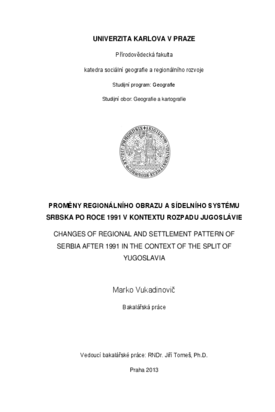Proměny regionálního obrazu a sídelního systému Srbska po roce 1991 v kontextu rozpadu Jugoslávie
Changes of Regional and Settlement Pattern of Serbia after 1991 in the Context of the Split of Yugoslavia
bakalářská práce (OBHÁJENO)

Zobrazit/
Trvalý odkaz
http://hdl.handle.net/20.500.11956/56365Identifikátory
SIS: 133199
Katalog UK: 990016276280106986
Kolekce
- Kvalifikační práce [21483]
Autor
Vedoucí práce
Oponent práce
Vrtiška, Tomáš Josef
Fakulta / součást
Přírodovědecká fakulta
Obor
Geografie a kartografie
Katedra / ústav / klinika
Katedra sociální geografie a region. rozvoje
Datum obhajoby
9. 9. 2013
Nakladatel
Univerzita Karlova, Přírodovědecká fakultaJazyk
Čeština
Známka
Velmi dobře
Klíčová slova (česky)
proměna, regionální obraz, systém osídlení, migrace, rozpad JugoslávieKlíčová slova (anglicky)
changes, regional pattern, settlement system, migration, war splitting of YugoslaviaProměny regionálního obrazu a sídelního systému Srbska po roce 1991 v kontextu rozpadu Jugoslávie Abstrakt Práce si klade za cíl analyzovat proměny regionálního obrazu a sídelního systému Srbska se zvláštním ohledem na migraci po válečném konfliktu vyvolaným rozpadem Jugoslávie začátkem devadesátých let. Zkoumá věkovou strukturu uprchlíků a vnitřně vysídlených osob a především jejich vliv na demografický růst Srbska a analyzuje závislost jejich místa pobytu na některých geografických a socioekonomických ukazatelích. Prověří také situaci uprchlíků v novém tisíciletí s ohledem na jejich repatriaci či naturalizaci. Závěrečná část práce zjišťuje, zda relativně značné procento této uprchlické populace stále žije v provizorních podmínkách a jak funguje spolupráce státu a agentur, které mají za cíl redukovat počet uprchlých a vnitřně vysídlených osob. Klíčová slova: proměna, regionální obraz, systém osídlení, migrace, rozpad Jugoslávie
Changes of regional and settlement pattern of Serbia after 1991 in the context of the split of Yugoslavia Abstract This thesis presents changes of regional and settlement pattern of Serbia with a special emphasis on migration after war events evoked by splitting of former Yugoslavia in the 90's. It researches age structure of refugees and internally displaced persons and mainly their influence on demographic growth of Serbia and analyses their dependence of their location on chosen geographical and economical indicators. It will also show the situation of refugees in the new millennium considering their repatriation or naturalization. The last part finds out, if there is a noticeable amount of refugee population living in temporary conditions and how works the cooperation between the state and organizations, which are supposed to reduce number of refugees and internally displaced persons. Key words: changes, regional pattern, settlement system, migration, war splitting of Yugoslavia
